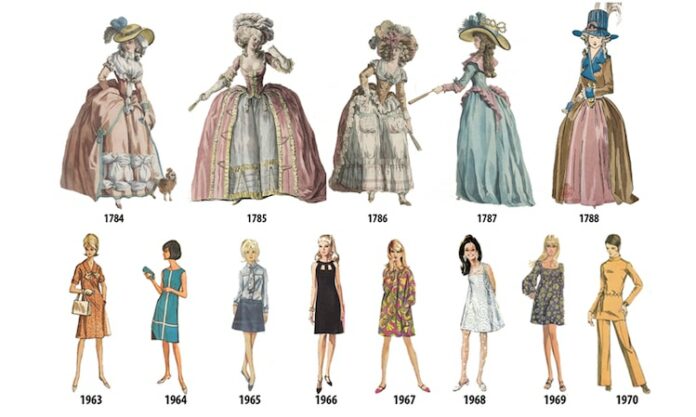The evolution of women’s fashion is more than a mere chronicle of garments and trends; it is an intricate tapestry interwoven with cultural norms, societal shifts, and political movements. Women’s attire has persistently reflected the zeitgeist of their respective eras, imbuing layers of meaning into notions of femininity, propriety, and autonomy. This essay endeavors to explore the historical underpinnings of women’s fashion, particularly focusing on the evolution of modesty and the phenomenon of “covering up.”
Understanding the genesis of women’s fashion requires an examination of historical contexts and prevailing ideologies. Thus, the journey begins in antiquity, when female attire first emerged as a reflection of societal expectations and class distinction.
In ancient civilizations such as Mesopotamia and Egypt, clothing served not only a functional purpose but also a symbolic one. Women donned garments that epitomized their social status and familial role. In Mesopotamia, for instance, women wore long garments known as “kaunakes,” which were often layered and stylistically complex. These fashions were a reflection of social stratification, wherein the wealthy embroidered their kaunakes with vibrant hues, indicating their affluence. Egyptian women, on the other hand, opted for simpler linen dresses, such as the “kalasiris,” which accentuated their form while still adhering to societal norms.
As we traverse through the annals of history, we notice an intriguing phenomenon in the advent of modesty within women’s fashion. The advent of Christianity heralded significant changes in attire, promoting virtues of chastity and humility. During the Byzantine Empire, women’s dress involved intricate layering, yet close adherence to principles of modesty was expected. The concept of covering the body became intertwined with piety and morality, a paradigm that persisted for centuries and influenced subsequent garment choices across Europe and the Middle East.
The Renaissance marked a turning point in women’s fashion, a period where societal affluence began to show through aesthetics. This era paralleled a heightened awareness of individualism and personal expression. Women’s garments became opulent, adorned with silk, lace, and elaborate embellishments. Although revealing in nature, the trend of using corsets to mold the female form underscored a dichotomy; the corset restricted mobility yet was celebrated as an epitome of beauty. This push-and-pull relationship between sensuality and suppression set the stage for modern understandings of femininity.
The late 18th and early 19th centuries witnessed the emergence of the Enlightenment, when notions of liberty and individual rights began to challenge established norms, including those concerning women’s attire. The French Revolution symbolized not merely a political upheaval but a sartorial revolution. Women began to abandon the constrictive fashions of previous eras in favor of simpler, neoclassical silhouettes. The rise of the “Empire line” dress, characterized by a high waistline just under the bust, can be viewed as emblematic of women’s burgeoning quest for autonomy. It reflected a movement toward a more natural form and an escape from traditional restrictions, encompassing both literal and metaphorical implications of freedom.
However, this newfound freedom was rather fleeting. The Victorian era saw a resurgence of modesty, as societal values emphasized propriety and female virtue. During this time, women were expected to adhere to stringent codes of decency that dictated every aspect of their appearance. Layers of fabric, crinolines, and longer hemlines became the norm, firmly situating women within the domestic sphere. Yet, the very act of dressing became a battleground for women’s rights. Notably, suffragettes employed fashion as a tool for activism, advocating for both voting rights and bodily autonomy. The adoption of bloomers as a more practical garment symbolized their fight against oppressive notions of gender.
The dawn of the 20th century heralded significant change; however, it was not without its contradictions. The two World Wars irrevocably altered women’s roles in society, as women took on jobs traditionally held by men, leading to practical sartorial choices that mirrored their newfound independence. The “flapper” emerged in the 1920s, characterized by bobbed hair, shorter hemlines, and a rejection of constrictive corsets—a momentous statement against the traditional modesty that dominated the previous century. These fashionable shifts evoked a sense of liberation, as women embraced their right to express themselves freely, both socially and sartorially.
Nonetheless, the mid-20th century brought forth yet another layer of complexity in women’s fashion. As post-war culture sought normalization and conformity, the prevailing fashion trends exuded a sense of domesticity and femininity that sought to negate the radical transformations of the preceding decades. The re-emergence of the “housewife” ideal manifested in clothing that epitomized modesty and traditional gender roles, ironically juxtaposed against the backdrop of women’s liberation movements.
The late 20th century was a crucible for the conflation of fashion with feminism. This epoch witnessed the influence of segments of society that sought to dismantle conventional gender roles by pushing the boundaries of attire. The 1960s and 1970s flaunted an explosion of style, with women reclaiming their bodies and their right to dress as they wished. Designers such as Yves Saint Laurent introduced revolutionary concepts, like the “Le Smoking” tuxedo suit for women, a sartorial statement that symbolized empowerment and gender equality.
Despite these advancements, a paradox remains entrenched in contemporary fashion. Modern society is often rife with conflicting ideologies regarding modesty and empowerment. While some women advocate for complete expression of their sexuality through fashion, others choose to embrace styles that reflect modesty, often rooted in personal, cultural, or religious beliefs. The choice to cover up or reveal can signify defiance against societal expectations or adherence to traditional customs, perennially blurring lines that delineate liberation.
In conclusion, the history of women’s fashion is not merely an account of styles and aesthetics; it involves the interplay of power, identity, and societal constructs. The question of when covering up began is intertwined with deeper inquiries about agency and autonomy. From the corsets of the Victorian era to the contemporary interpretations of modest fashion, it is evident that clothing serves as an intricate dialogue expressing a woman’s role in society. Understanding this evolution is crucial in fostering conversations that expand the understanding of empowerment and femininity within modern contexts.





























